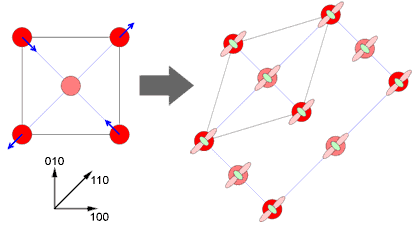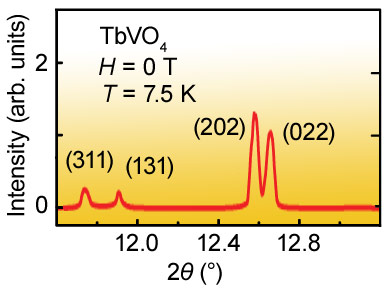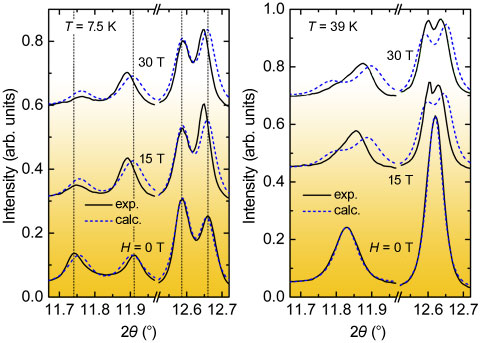- Home
- News
- Spotlight on Science
- First results for...
First results for synchrotron X-ray powder diffraction study in pulsed high magnetic fields
10-06-2008
Research at the ESRF provides the first direct evidence for the modification of the cooperative Jahn-Teller effect in terbium ortho-vanadate by an external magnetic field.
Share
Pulsed magnetic fields represent an economical way of accessing high magnetic fields beyond the superconducting limit (which presently stands at about 15 T). Recently this technique has been introduced at several synchrotron light sources. However, the short pulse lengths and long waiting times between pulses represent a significant challenge that can only be met through innovative measurement strategies, and adaptation of the coil and cryostat to the particular requirements of synchrotron experiments [1, 2]. While the principle has been demonstrated both at Spring-8 and the ESRF, experimental results remain rare. In a recent experiment on the CRG beamline BM26 (DUBBLE) at the ESRF, the scientists managed to overcome these difficulties and directly measured the effect a 30 T magnetic field has on the Jahn-Teller effect in TbVO4.
Terbium ortho-vanadate TbVO4, is a textbook example of a material exhibiting the cooperative Jahn-Teller (JT) effect driven by phonon-mediated interactions between the Tb quadrupole moments. At high temperatures, it crystallises in the tetragonal zircon structure, whereas on lowering the temperature below about 33 K it undergoes a cooperative JT transition whereby the crystal spontaneously distorts along the [110] direction, lowering the symmetry to orthorhombic (Figure 1). The balance between TbVO4’s magnetostrictive effect and paramagnetism vs. quadrupolar interactions can be tuned by varying the strength of an applied field. The effect of large external magnetic fields on TbVO4 has only recently been studied. It was predicted by theory that the JT distortion would be suppressed when fields above 29 T are applied along the c axis of the sample [3].
 |
|
Figure 1. Spontaneous tetragonal to orthorhombic distortion of the structure originating at the Jahn-Teller transition. |
In the current experiment, the sample was placed in an environment permitting application of high magnetic fields while monitoring changes using X-ray diffraction. The sample consisted of finely powdered crystals of TbVO4 embedded in polyvinylpyridone to prevent movement of the powder grains due to magnetic forces. Data were collected by accumulating about 45 magnetic field pulses per powder diffraction spectrum. The JT transition manifests itself as a splitting of some of the powder lines in the spectrum due to the distortion of the crystal lattice. Within the photon energy range studied, the (311)/(131) and (202)/(022) pairs of reflections are sensitive to the JT distortion, these are shown in Figure 2.
 |
|
Figure 2. Part of the X-ray powder diffraction spectra of TbVO4 taken at T=7.5 K, showing the (311)/(131) and (202)/(022) pairs of reflections sensitive to the JT distortion. |
Spectra taken at different field strengths are presented in Figure 3. Without an external magnetic field, the spectra taken at temperatures of 7.5 K and 39 K closely follow theoretical predictions and twin peaks in the former and single peaks in the latter can be seen, i.e. these temperatures are below and above the J-T transition temperature, respectively. At 15 and 30 T, the spectra show splitting of the peaks at 39 K, thus providing evidence for the modification of the J-T distortions of TbVO4 by magnetic fields (see Figure 3). Although, the observed splitting followed the predicted spectra, the degree of splitting was lower than expected. Various theories to explain the quantitative difference have been proposed, one being sample heating due to the magnetocaloric effect.
Technology for high magnetic fields will be further developed at the ESRF in collaboration with LNCMP-Toulouse in view to making this facility available at different beamlines.
References
[1] P. Frings (a), J. Vanacken (b), C. Detlefs (c), F. Duc (a), J.E. Lorenzo (d), M. Nardone (a), J. Billette (a), A. Zitouni (a), W. Bras (e) and G.L.J.A. Rikken (a), Rev. Sci. Instr. 77, 063903 (2006).
[2] Y. Matsuda, Y. Ueda, H. Nojiri, T. Takahashi, T. Inami, K. Ohwada, Y. Murakami, and T. Arima, Physica (Amsterdam) 346–347B, 519 (2004).
[3] A.A. Demidov and N.P. Kolmakova, Physica (Amsterdam), 363B, 245 (2005).
Principle publication and authors
C. Detlefs (a), F. Duc (b), Z.A. Kazeĭ (c), J. Vanacken (d), P. Frings (b), W. Bras (e), J.E. Lorenzo (f), P.C. Canfield (g), and G.L.J.A. Rikken (b), Direct Observation of the High Magnetic Field Effect on the Jahn-Teller State in TbVO4, Phys. Rev. Lett. 100, 056405 (2008).
(a) ESRF
(b) Laboratoire National des Champs Magnétiques Pulsés, CNRS-INSA-UPS, Université de Toulouse (France)
(c) Moscow State University (Russia)
(d) Pulsveldengroep, Institute for Nanoscale Physics and Chemistry, Leuven (Belgium)
(e) Netherlands Organisation for Scientific Research (NWO), DUBBLE CRG at the ESRF, Grenoble (France)
(f) Institut Neél, CNRS, Grenoble (France)
(g) Ames Laboratory, USDOE and Department of Physics and Astronomy, Iowa State University (USA)
What's related?
- Spotlight July 2007 for the HRRS beamline ID18: Nuclear forward scattering in pulsed magnetic fields
- Spotlight January 2008 for the XAMS beamline ID24: Exploring magnetism within extreme magnetic fields
- Highlight 2006 corresponding to ref. [1]: Synchrotron X-ray powder diffraction studies in pulsed magnetic fields




